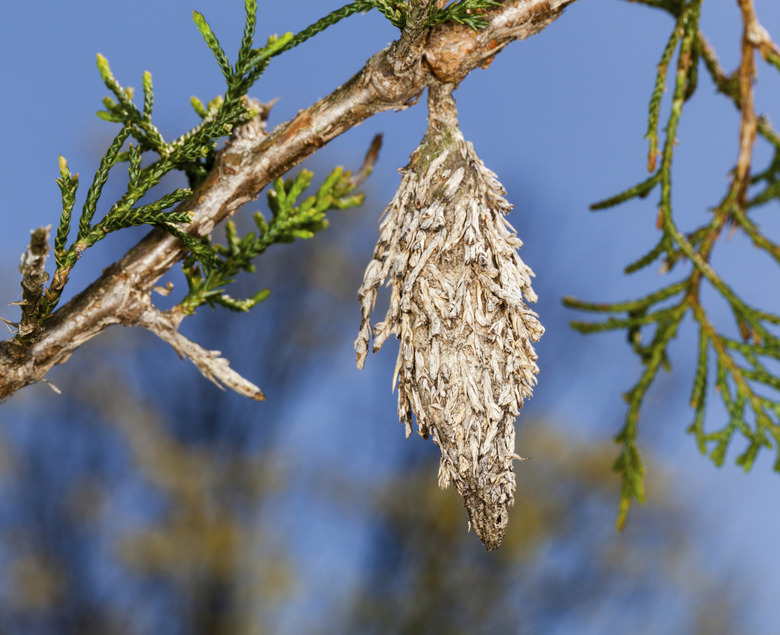Caterpillars That Eat Evergreen Bushes
Tough, pungent-smelling evergreen foliage is usually free of pests, but some caterpillars are adapted to feed on the needles or scales of evergreen shrubs such as juniper (Juniperus spp.) and arborvitae (Thuja spp.). The caterpillars are mostly larvae of different kinds of moths. A caterpillar-like larva belongs to a wasp relative called a sawfly. Caterpillars are easiest to control if you find them while they are still small.
Step 1
Usually you don't see the bagworm caterpillar itself. What you notice is the silken bag, decorated with bits of foliage and bark, that it spins around its body as a shelter. The caterpillar enlarges the bag as it feeds during the summer, finally attaching the sack to a branch or leaves, where pupation and overwintering occurs. The wingless female never leaves the bag. She contains between 300 and 1,000 eggs, which hatch in the spring. A large infestation can defoliate an evergreen shrub. Among evergreen bagworm hosts are Leyland cypress (x Cupressocyparis leylandii), hardy in U.S. Department of Agriculture plant hardiness zones 5 through 9, and arborvitae, generally hardy to USDA zones 4 through 11. Control bagworms by handpicking and destroying the bags before eggs hatch in the spring. Once caterpillars hatch, treat them while they are under 3/4 inch long with Bacillus thuringiensis, or B.t.
Step 2
- Usually you don't see the bagworm caterpillar itself.
- The caterpillar enlarges the bag as it feeds during the summer, finally attaching the sack to a branch or leaves, where pupation and overwintering occurs.
Bacillus Thuringiensis
Step 1
Bacillus thuringiensis is also effective against moth caterpillars. Once in the digestive tract, the bacteria produce a toxic protein that paralyzes the digestive system, and the caterpillar dies from starvation. Mix 1 to 2 teaspoons of the insecticide thoroughly with 1 gallon of water. Spray the solution on all surfaces of the shrub, wetting upper and lower needle surfaces and the branches. If feeding activity continues due to newly hatched caterpillars, repeat the application at three- to 14-day intervals.
Juniper Webworm
Step 1
Juniper webworm larvae are yellow to brown and have dark heads. Young caterpillars tunnel inside the juniper leaves. As they get bigger, they eat whole leaves, gathering in groups and spinning webs. Look for the small, 1/2-inch-long caterpillars, their webbing, and the brown color of damaged leaves. For control, hand-pick the larvae, prune off infected branches and destroy them, or treat with B.t. Shrub junipers that can be hosts include Chinese juniper (Juniperus chinensis), hardy in U.S. Department of Agriculture plant hardiness zones 3 through 11, and creeping juniper (Juniperus horizontalis), hardy in USDA zones 3 through 10.
Step 2
Step 3
- Bacillus thuringiensis is also effective against moth caterpillars.
- For control, hand-pick the larvae, prune off infected branches and destroy them, or treat with B.t.
Arborvitae Leaf Miner
Step 1
The very small leaf miner caterpillars don't live freely on the surface of the arborvitae. Instead, they tunnel into the leaves, turning the foliage yellow and then brown. If you hold the infested needles up to the light you can see the larvae and their feeding wastes inside the affected leaves. A number of natural enemies such as parasitic wasps help control leaf miner populations. Limit population spread by pruning off and destroying infected branches. Some shrub arborvitae that might be affected are cultivars of eastern arborvitae (Thuja occidentalis), hardy in USDA zones 4 through 7, and Oriental arborvitae (Thuja plicata), hardy in USDA zones 6 through 11.
Juniper Sawfly
Step 1
Orange-colored female juniper sawflies (Monoctenus fulvus) don't have stingers, as do many other wasp family members. Instead they have a saw-like ovipositor for laying eggs in the shoot tips of junipers. The larvae look like caterpillars and are grayish-green with an orange head. They eat primarily the tips of juniper shoots, resulting in a thinned appearance and a temporary slowdown of new growth. Juniper sawflies feed on a number of juniper species, including eastern red cedar (Juniperus virginiana), hardy in USDA zones 2 through 9. You can wash sawfly larvae off evergreens with a strong spray of water. A number of natural enemies help keep sawfly populations in check.
Step 2
- The very small leaf miner caterpillars don't live freely on the surface of the arborvitae.
References
- University of Illinois Extension: Managing Bagworms and Tent Caterpillars
- North Carolina Cooperative Extension: The Worm Is Out of the Bag
- Washington State University: Juniper: Juniper Webworm
- University of Illinois Extension: Arborvitae Leaf Miner
- Colorado State University Cooperative Extension: Insects That Feed On Colorado Trees and Shrubs
- University of Nebraska–Lincoln Extension: Small Greenish Caterpillars Are Eating On My Evergreen Trees. What Are These Insects and how Can I Control Them?
- National Gardening Association: Arborvitae
- Arizona State University: Juniperus Chinensis
- Floridata: Juniperus Horizontalis
